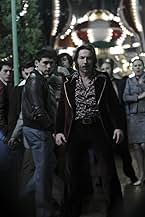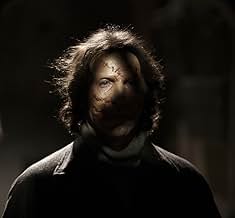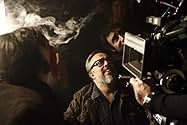CALIFICACIÓN DE IMDb
6.5/10
16 k
TU CALIFICACIÓN
Una trapecista tiene que decidir entre la lujuria que le despierta Sergio, el Payaso Feliz, o el afecto de Javie, el Payaso Triste, pero ambos están trastornados.Una trapecista tiene que decidir entre la lujuria que le despierta Sergio, el Payaso Feliz, o el afecto de Javie, el Payaso Triste, pero ambos están trastornados.Una trapecista tiene que decidir entre la lujuria que le despierta Sergio, el Payaso Feliz, o el afecto de Javie, el Payaso Triste, pero ambos están trastornados.
- Dirección
- Guionista
- Elenco
- Premios
- 11 premios ganados y 21 nominaciones en total
Alejandro Tejerías
- Motorista-fantasma
- (as Alejandro Tejería)
Sasha Di Bendetto
- Javier (Niño 1937)
- (as Sasha Di Bendetto)
- Dirección
- Guionista
- Todo el elenco y el equipo
- Producción, taquilla y más en IMDbPro
Opiniones destacadas
The first reaction I had to this film was - "an overkill". So much gore and blood in a small love triangle story, seemed excessive. But my very next thought was, I must be missing something. And as I went over the perfectly designed gory details of the movie one more time in my mind I realized I was watching a surreal fable on the fate of Spain from the Spanish civil war onward. The only proof of that claim I can give here without adding a spoiler is the fact that the opening scene of the film takes place in 1937 while most of the story happens on 1973, but there's no logical base for such a big time gap, the only reason these two dates were chosen is because the second is the mirror image of the first, and they both fit into the historic background necessary for the story.
As a fable, we have all the right ingredients of a fable in, the characters may be slightly flat, since their symbolic value is more important than their personality but the actors make it work anyhow.
So if your stomach can take gore and blood in quantities that would suit a horror movie, and you're interested in an original point of view on the destiny of Spain in the 20th century - it's definitely worth seeing
As a fable, we have all the right ingredients of a fable in, the characters may be slightly flat, since their symbolic value is more important than their personality but the actors make it work anyhow.
So if your stomach can take gore and blood in quantities that would suit a horror movie, and you're interested in an original point of view on the destiny of Spain in the 20th century - it's definitely worth seeing
Greetings again from the darkness. Here's hoping I don't get booted from proper society for admitting a strange fascination and enjoyment from the latest directorial effort by Spanish cult favorite Alex de la Iglesia. The film is assembled with unequal parts: political parody, black comedy, dark horror, bizarre action and an even more bizarre love triangle. All of that and some of the freakiest clowns you will ever see! I am not really familiar with Mr. De La Torre's previous work but evidently he has quite a following in Spain, though he has found extremely limited success in the U.S. with The Day of the Beast. Neither am I an historical expert on the Spanish Civil War or the regime of Generalissimo Francisco Franco, both of which are targets of the director's true feelings. Still, the movie is such that it kept me engaged and even enthralled the entire time ... especially in Act I.
The film begins in 1937 when a faction of the Republican Army crash a kids' circus performance and force the performers to join in the crusade. One of the clowns leaves behind a young son as he picks up a machete and destroys a platoon almost single handedly - while still in women's clown costume! It is a visual I have yet to erase from my memory.
Forward to 1943 and the clown is forced into servitude constructing the famed Valley of the Fallen. His son tracks him down and is given "revenge" as the only redemptive action by his father. Flash forward to 1973 and the young boy is seen joining a traveling circus as the "sad clown". This circus troupe is run by the ruthless and sadistic "funny clown" who is clearly the filmmakers representation of Franco. The foreshadowing scene comes in the initial meeting between the two clowns as 'funny' tells 'sad' if he weren't a clown, he'd be a murderer. "Sad" responds "me too". Let the mayhem begin! The rivalry and violence escalates as Javier, the sad clown, is lead on and falls for the acrobatic girlfriend of Sergio, the funny clown. As the story moves forward both Javier and Sergio become more grotesque and violent in their attempts to capture Natalia the acrobat. It all ends with a breathtaking climb and operatic duel atop the memorial in the Valley of the Fallen.
There is no way to describe the trip from machete clown to the tragic dance atop the cross. It is a mash-up of Inglorious Basterds, Freaks, Machete and Phantom of the Opera. Additionally, there are countless homages to classic films through the years and a nearly operatic feel to the story and some scenes. Singer Raphael's version of "Ballad of the Sad Trumpet" plays a role, as does a crumpled trumpet. I certainly see this one becoming a regular on the midnight movie circuit, and rightfully so. It has everything a viewer could possibly want ... provided they are in a mindless stupor and looking for the best available violent clown movie currently showing!
The film begins in 1937 when a faction of the Republican Army crash a kids' circus performance and force the performers to join in the crusade. One of the clowns leaves behind a young son as he picks up a machete and destroys a platoon almost single handedly - while still in women's clown costume! It is a visual I have yet to erase from my memory.
Forward to 1943 and the clown is forced into servitude constructing the famed Valley of the Fallen. His son tracks him down and is given "revenge" as the only redemptive action by his father. Flash forward to 1973 and the young boy is seen joining a traveling circus as the "sad clown". This circus troupe is run by the ruthless and sadistic "funny clown" who is clearly the filmmakers representation of Franco. The foreshadowing scene comes in the initial meeting between the two clowns as 'funny' tells 'sad' if he weren't a clown, he'd be a murderer. "Sad" responds "me too". Let the mayhem begin! The rivalry and violence escalates as Javier, the sad clown, is lead on and falls for the acrobatic girlfriend of Sergio, the funny clown. As the story moves forward both Javier and Sergio become more grotesque and violent in their attempts to capture Natalia the acrobat. It all ends with a breathtaking climb and operatic duel atop the memorial in the Valley of the Fallen.
There is no way to describe the trip from machete clown to the tragic dance atop the cross. It is a mash-up of Inglorious Basterds, Freaks, Machete and Phantom of the Opera. Additionally, there are countless homages to classic films through the years and a nearly operatic feel to the story and some scenes. Singer Raphael's version of "Ballad of the Sad Trumpet" plays a role, as does a crumpled trumpet. I certainly see this one becoming a regular on the midnight movie circuit, and rightfully so. It has everything a viewer could possibly want ... provided they are in a mindless stupor and looking for the best available violent clown movie currently showing!
After the really disappointing "Oxford murders", Álex de la Iglesia returns with not only his best film to date, but with one of the best films in the last years. "Balada Triste de Trompeta" is a romantic-over the top-violent melodrama which mixes Tarantino, Hitchcock, Fellini, Todd Browning and of course it also has a lot of previous Álex de la Iglesia films like "Acción Mutante" or "El día de la bestia". Two men, one good and one bad, fighting for the love of a beautiful blonde trapeze artist (the gorgeous Carolina Bang) in a downward spiral of love and madness that also serves as a historical recount of the last 75 years of Spanish history.
To watch this movie and enjoy it one must suspend all judgment.
It doesn't pretend to show us scenes of everyday living, or the girl next door shopping at the supermarket.
It deals with the same magic world that García Márquez deals with in his exotic novels. Marvellously created world. As thrilling as any Fellini movie. The circus world is the perfect setting for developing this view, between fantasy, nightmares and awful reality.
The pacing is relentless, a thousand things happening during the 120 minutes or so, all of them linked within the main story and showing a whole range of human emotions among the three main characters: The Smiling Clown, The Sad Clown (his sidekick) and the beautiful trapeze girl, the object of jealousy, fury, rancor between the two clowns.
Every scene is visually baroque in essence, since action takes place in the foreground but also in the background, with secondary characters.
There is a full color palette, dazzling as an old kaleidoscope making all sorts of beautiful patterns that change in front of our eyes delighting us continuously.
The acting is superb, from the principal actors to the last extra. The delivery of the lines in Spanish is done at full speed, clean as a whistle and sharp as a cracking whip by all the actors.
The digital effects perfect. Top entertainment from beginning to end. What a SEN-SA-TION-AL movie!!!
It doesn't pretend to show us scenes of everyday living, or the girl next door shopping at the supermarket.
It deals with the same magic world that García Márquez deals with in his exotic novels. Marvellously created world. As thrilling as any Fellini movie. The circus world is the perfect setting for developing this view, between fantasy, nightmares and awful reality.
The pacing is relentless, a thousand things happening during the 120 minutes or so, all of them linked within the main story and showing a whole range of human emotions among the three main characters: The Smiling Clown, The Sad Clown (his sidekick) and the beautiful trapeze girl, the object of jealousy, fury, rancor between the two clowns.
Every scene is visually baroque in essence, since action takes place in the foreground but also in the background, with secondary characters.
There is a full color palette, dazzling as an old kaleidoscope making all sorts of beautiful patterns that change in front of our eyes delighting us continuously.
The acting is superb, from the principal actors to the last extra. The delivery of the lines in Spanish is done at full speed, clean as a whistle and sharp as a cracking whip by all the actors.
The digital effects perfect. Top entertainment from beginning to end. What a SEN-SA-TION-AL movie!!!
If you have seen any film by Alex de la Ingelsia, then you know that no two of his films are alike, that they contain a lot of humor and arresting images, and often a lot of graphic gores, and are the product of a very original mind. THE LAST CIRCUS is no exception. There are images in this film that will stay with you for years.
The settings are many and varied, beginning with the Spanish Civil War in 1937 and winding up in 1973 on a War Monument that includes a giant cross and statues for an ending that will bring to mind Hitchcock's NORTH BY NORTHWEST. Along the way there is a nightclub dedicated to Telly Savalas called Kojak!
Pedro Rodríguez has created two very different special effects makeups, one of a man who has self-mutilated his face with acid and a hot iron, and another by man who has had his face slashed with a grappling hook and then stitched back together by a veterinarian. Rodríguez is someone whose future work bears watching.
The setting for much of the action is a traveling circus reminiscent of FREAKS crossed with Alejandro Jodorowsky's SANTA SANGRE. Clowns have always been pretty creepy anyway, but you will never look at them the same after this film.
The settings are many and varied, beginning with the Spanish Civil War in 1937 and winding up in 1973 on a War Monument that includes a giant cross and statues for an ending that will bring to mind Hitchcock's NORTH BY NORTHWEST. Along the way there is a nightclub dedicated to Telly Savalas called Kojak!
Pedro Rodríguez has created two very different special effects makeups, one of a man who has self-mutilated his face with acid and a hot iron, and another by man who has had his face slashed with a grappling hook and then stitched back together by a veterinarian. Rodríguez is someone whose future work bears watching.
The setting for much of the action is a traveling circus reminiscent of FREAKS crossed with Alejandro Jodorowsky's SANTA SANGRE. Clowns have always been pretty creepy anyway, but you will never look at them the same after this film.
¿Sabías que…?
- TriviaAccording with Álex de la Iglesia, Raphael watched the movie before the public premieres, and he didn't like voice acting of the actor who played him. De la Iglesia offered him to dub himself, and finally is Raphael's voice which is heard in the movie.
- ErroresWhen Andres is arrested, he says "maderos" to the policemen, but this word was not yet used at this time. He shoould have said "grises" (grey) because this is the color of the police uniform - only years later would it become brown. ("Madero" is log or piece of wood, which is why people called policemen "maderos").
- ConexionesFeatured in Half in the Bag: Robot and The Last Circus (2011)
- Bandas sonorasTitles
Vocals by Manuel Tallafé
Performed by 'Banda de cornetas de la Fundacion Julian Santos'
2015 Melliam Music
Selecciones populares
Inicia sesión para calificar y agrega a la lista de videos para obtener recomendaciones personalizadas
- How long is The Last Circus?Con tecnología de Alexa
Detalles
- Fecha de lanzamiento
- Países de origen
- Sitios oficiales
- Idioma
- También se conoce como
- The Last Circus
- Locaciones de filmación
- Barrio El Partidor, Alcoy, Alicante, Comunidad Valenciana, España(as Madrid's suburbs, circus exteriors)
- Productoras
- Ver más créditos de la compañía en IMDbPro
Taquilla
- Presupuesto
- EUR 7,000,000 (estimado)
- Total en EE. UU. y Canadá
- USD 40,548
- Fin de semana de estreno en EE. UU. y Canadá
- USD 4,757
- 21 ago 2011
- Total a nivel mundial
- USD 3,604,598
- Tiempo de ejecución1 hora 47 minutos
- Color
- Mezcla de sonido
- Relación de aspecto
- 2.35 : 1
Contribuir a esta página
Sugiere una edición o agrega el contenido que falta

Principales brechas de datos
By what name was Balada triste de trompeta (2010) officially released in India in English?
Responda






























